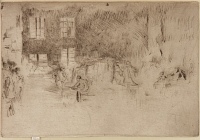Etchings Institutions search term: caxton club
Murano - Glass Furnace | ||
| Number: | 205 | |
| Date: | 1879/1880 | |
| Medium: | drypoint | |
| Size: | 161 x 238 mm | |
| Signed: | no | |
| Inscribed: | no | |
| Set/Publication: | no | |
| No. of States: | 4 | |
| Known impressions: | 7 | |
| Catalogues: | K.217; M.214; W.187 | |
| Impressions taken from this plate (7) | ||
PUBLICATION
EXHIBITIONS
13: London FAS 1883 (cat. no.1); see REFERENCES: EXHIBITIONS.
14: 'Mr Whistler's Etchings', Daily News, 20 February 1883 (GUL PC25/20).
15: 'An Arrangement in White and Yellow', [February 1883], unidentified press-cutting, GUL PC25/26.
16: Knowledge, III, 6 April 1883, pp. 208-9, repr.
 ). 17 Another - possibly bought from Wunderlich's - was lent by Bryan Lathrop (1844-1916) to a show organised by the Caxton Club in Chicago in 1900 (
). 17 Another - possibly bought from Wunderlich's - was lent by Bryan Lathrop (1844-1916) to a show organised by the Caxton Club in Chicago in 1900 ( ). 18
). 18
17: London Obach 1903 (cat. no. 164).
18: Chicago 1900 (cat. no. 167).
 ). 19
). 19
19: London Mem. 1905 (cat. no. 187).
SALES & COLLECTORS
 ). Messrs Dowdeswell, after consulting Wedmore's catalogue of Whistler's etchings, wrote to Whistler to request impressions of a number of etchings, including this. 20 Whistler sold three impressions of 'Murano Glass Furnace' to Dowdeswell's more or less by return of post, on 16 February 1889, and another on 3 August 1889, for £5.5.0 each. 21
). Messrs Dowdeswell, after consulting Wedmore's catalogue of Whistler's etchings, wrote to Whistler to request impressions of a number of etchings, including this. 20 Whistler sold three impressions of 'Murano Glass Furnace' to Dowdeswell's more or less by return of post, on 16 February 1889, and another on 3 August 1889, for £5.5.0 each. 21
 ). Another - a third state - was bought by John Charles Sigismund Day (1826-1908) (
). Another - a third state - was bought by John Charles Sigismund Day (1826-1908) ( ); in 1906 this was with Obach & Co., in London and was bought by Charles Lang Freer (1856-1919). Freer had already bought a fourth state from Obach's in 1903 (
); in 1906 this was with Obach & Co., in London and was bought by Charles Lang Freer (1856-1919). Freer had already bought a fourth state from Obach's in 1903 ( ). Both are likely to have come originally from Dowdeswell's, and were bequeathed with the rest of his important collection to the Freer Gallery of Art in Washington DC. Another impression that may have come from Dowdeswell's was owned by Joshua Hutchinson Hutchinson (ca 1829 - d.1891) and bought after his death by Edmund F. Deprez (1851-1915) of Duprez & Gutekunst for £1.18.0. 22
). Both are likely to have come originally from Dowdeswell's, and were bequeathed with the rest of his important collection to the Freer Gallery of Art in Washington DC. Another impression that may have come from Dowdeswell's was owned by Joshua Hutchinson Hutchinson (ca 1829 - d.1891) and bought after his death by Edmund F. Deprez (1851-1915) of Duprez & Gutekunst for £1.18.0. 22
22: Sotheby's, 3 March 1892 (lot 282).
 ), Harry Brisbane Dick (1855-1916) (
), Harry Brisbane Dick (1855-1916) ( ), Samuel Putnam Avery (1822-1904) (
), Samuel Putnam Avery (1822-1904) ( ) or Bryan Lathrop (1844-1916) (
) or Bryan Lathrop (1844-1916) ( ). From these, the prints travelled either directly or through others to major American collections: the Library of Congress, the Metropolitan Museum of Art, New York Public Library, and the Art Institute of Chicago.
). From these, the prints travelled either directly or through others to major American collections: the Library of Congress, the Metropolitan Museum of Art, New York Public Library, and the Art Institute of Chicago.23: Wunderlich's to Whistler, 24 March 1899, GUW #07305.
